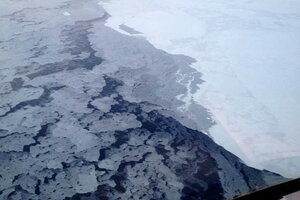Global warming: Ice loss makes Arctic itself a bigger climate changer
As the Arctic region loses ice cover to global warming, it is itself becoming a stronger contributor to warming than climate models had predicted it would, a new study finds.

NOAA distributed this photo of Arctic ice in December 2013. The Arctic isn't nearly as bright and white as it used to be because of more ice melting in the ocean, and that's turning out to be a global problem, a new study says. With more dark, open water in the summer, less of the sun's heat is reflected back into space, so the entire Earth is absorbing more heat than expected.
NOAA/AP
A long-term darkening of the Arctic region – occurring as sea ice retreats in the face of warmer summers – has been a stronger contributor to global warming during the past 32 years that previously estimated, according to a new study.
The Arctic's contribution over this period is about 25 percent of the warming the climate has undergone from carbon dioxide (CO2) emissions alone, say the researchers. That's "considerably higher" than estimates from climate models or from studies that use less-direct methods of measuring, they have found.
The average darkening of the Arctic's surface is a result of a long-term decline in the extent of sea ice in the summer. This leaves an increasing expanse of dark, open ocean to absorb summer sunlight that otherwise would be reflected back into space. The ocean absorbs the incoming sunlight, then returns the radiation to the atmosphere as heat. The same process occurs with melt ponds that form on the surface of remaining ice.
The results confirm, for the first time by direct observation, a 50-year-old idea that warming would become more intense in the Arctic than at lower latitudes, thanks to sea-ice loss.
Rising greenhouse-gas concentrations, triggered by land-use changes and by burning fossil fuels, would trigger the ice losses initially. Then, these losses would gradually present a darker ocean surface to incoming sunlight, the Arctic region would warm, and the additional warming would further reduce sea ice and amplify the warming.
The Arctic has warmed, in fact, by about 2 degrees Celsius (3.6 degrees Fahrenheit) since the 1970s – a change about three times larger than the warming that has occurred at lower latitudes.
Previous studies had shown a link between sea ice loss and the Arctic's gradually declining ability to reflect sunlight back into space, a trait known as albedo.
Because of those earlier results, and because the Arctic Ocean covers such a small area of the planet, "I didn't expect to find such a big signal" on warming globally from sea-ice loss, says Ian Eisenman, a climate researcher at the Scripps Institution of Oceanography in La Jolla, Calif., and one of three Scripps researchers reporting the results in the current issue of the Proceedings of the National Academy of Sciences.
"I was surprised to find such a big number and to find that sea ice has been that important a player in the global warming that we've observed in recent decades," he says.
The team used satellite measurements of sea-ice extent and of the amount of sunlight the Arctic reflects, as well as infrared radiation the region emits, to pin down changes in the Arctic's albedo. It gathered the measurements between 2000 and 2011.
Using the relationship observed in the data between sea ice changes and the region's albedo, the team calculated the albedo change between 1979 and 2000.
The researchers compared their results with those from climate models, which generally have underestimated the retreat of summer sea ice, says Christina Pistone, lead author of the paper, which also included work from climate researcher Veerabhadran Ramanathan. The model the team used for its comparisons did a good job of reproducing the relationship between sea-ice loss and albedo that the team found in the real-world measurements.
Still, the researchers note that the model yielded an Arctic with a higher albedo, reflecting more light back into space, than the satellite data yielded.
The results also appear to suggest that cloud cover over the region is not changing significantly, despite the warming and the additional open water available each summer to provide the moisture for producing clouds.
Some researchers had suggested that cloud cover would increase with warming over the Arctic Ocean, perhaps slowing the pace of warming by raising the region's albedo somewhat compared with clear skies, which would leave remaining ice and ocean exposed to the sun.
The 2000-2011 data suggest "that clouds wouldn't save you," says Don Perovich, a researcher at the US Army Corps of Engineers' Cold Regions Research and Engineering Laboratory in Hanover, N.H., who was not a member of the research team.
Pistone and her colleagues caution that their estimate of the energy the Arctic's lower albedo adds to the atmosphere may not be entirely due to warming's effect on ice extent. Some of the ice decline may be attributed to natural variability, as well as to the warming effect of black-carbon soot, which winds deliver from lower latitudes.
Still, the impact of the Arctic's declining albedo on global climate is nothing to sneer at, suggests Dr. Perovich. Noting the additional energy the loss of sea ice is adding to the climate system globally compared with CO2, "that's some serious leverage," he says.

